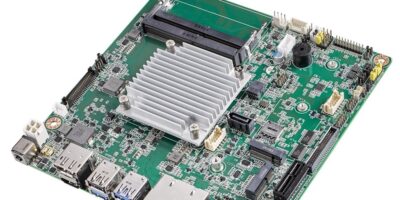A low-profile, fanless, industrial-grade Mini-ITX motherboard from Advantech is based on Intel’s Atom x6000E, Intel Pentium and Celeron N and J series processors.
Based on low power (six to 12W TDP), 10nm technology, the AIMB-218 supports up to four cores with 3.0GHz turbo frequency and up to 850MHz of Gen 11 graphics. The latest processor technology doubles the graphics processing capabilities and increases CPU performance by up to 50 per cent, compared with the previous Atom devices, explains Advantech.
The AIMB-218 is designed for industrial edge computing applications which require high resolution graphics and low power consumption. Typical uses would be in retail displays, smart kiosks, digital signage, smart manufacturing, medical devices and traffic and parking systems for smart cities. Operating temperature is -20 to +70 degrees C.
In addition to the graphics capabilities of the Intel UHD Graphics, the AIMB-218 supports rich display interfaces, including DisplayPort 1.2, HDMI 1.4, LVDS and eDP and also delivers 4K resolution progressive scan at 60 frames per second on three displays. The motherboard also has an improved memory capacity via DDR4 3200MHz up to 32Gbyte with IBECC. AIMB-218’s graphics, high-speed memory, storage, and data transfer rate capabilities achieve low latency for high resolution video content in embedded display control applications, adds Advantech.
The AIMB-218 features diverse I/O, including dual GbE LAN ports, three USB 3.2 Gen2, five USB 2.0 and one SATA III. It also supports six high speed COM ports, capable of 1Mbits per second. The COM1 port supports 5V/12V and COM2 supports RS-232, RS-422 or RS-485 auto-flow control. The COM ports improve data synchronisation precision over the network and reduce latency during device communication, Advantech says.
The Mini-ITX Motherboard offers one PCIe Gen. 3 for improved artificial intelligence (AI) capabilities. There is also a M.2 Slot (E key) for Wi-Fi and Bluetooth module, and a M.2 Slot (B Key) with SIM card holder for LTE and mSATA modules.
AIMB-218L/J/D use the Intel Pentium and Celeron N and J Series processors and is available now. The AIMB-218Z, based on the Intel Atom x6000E Series, is scheduled to be available in Q2, 2021. Samples are available now.







